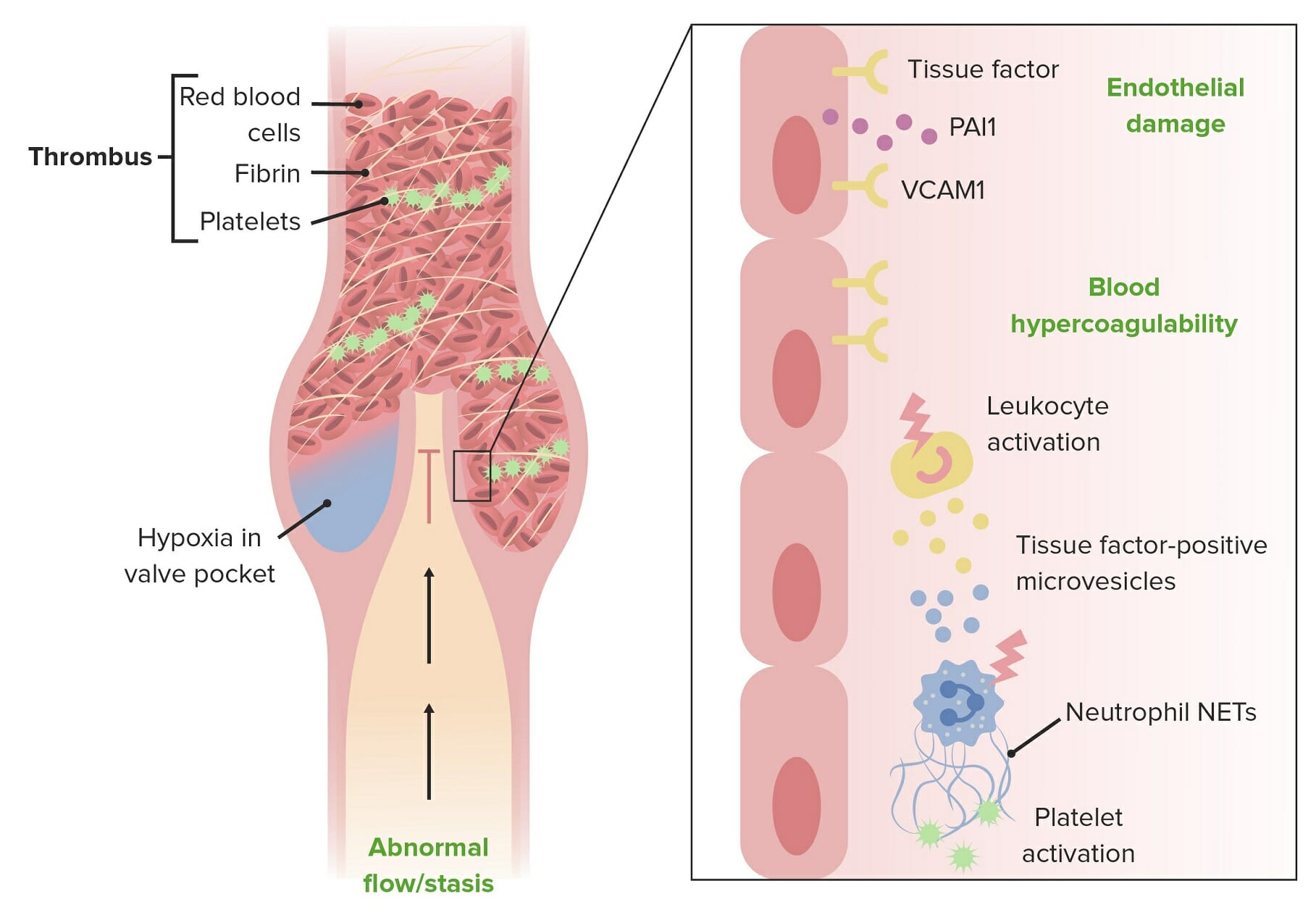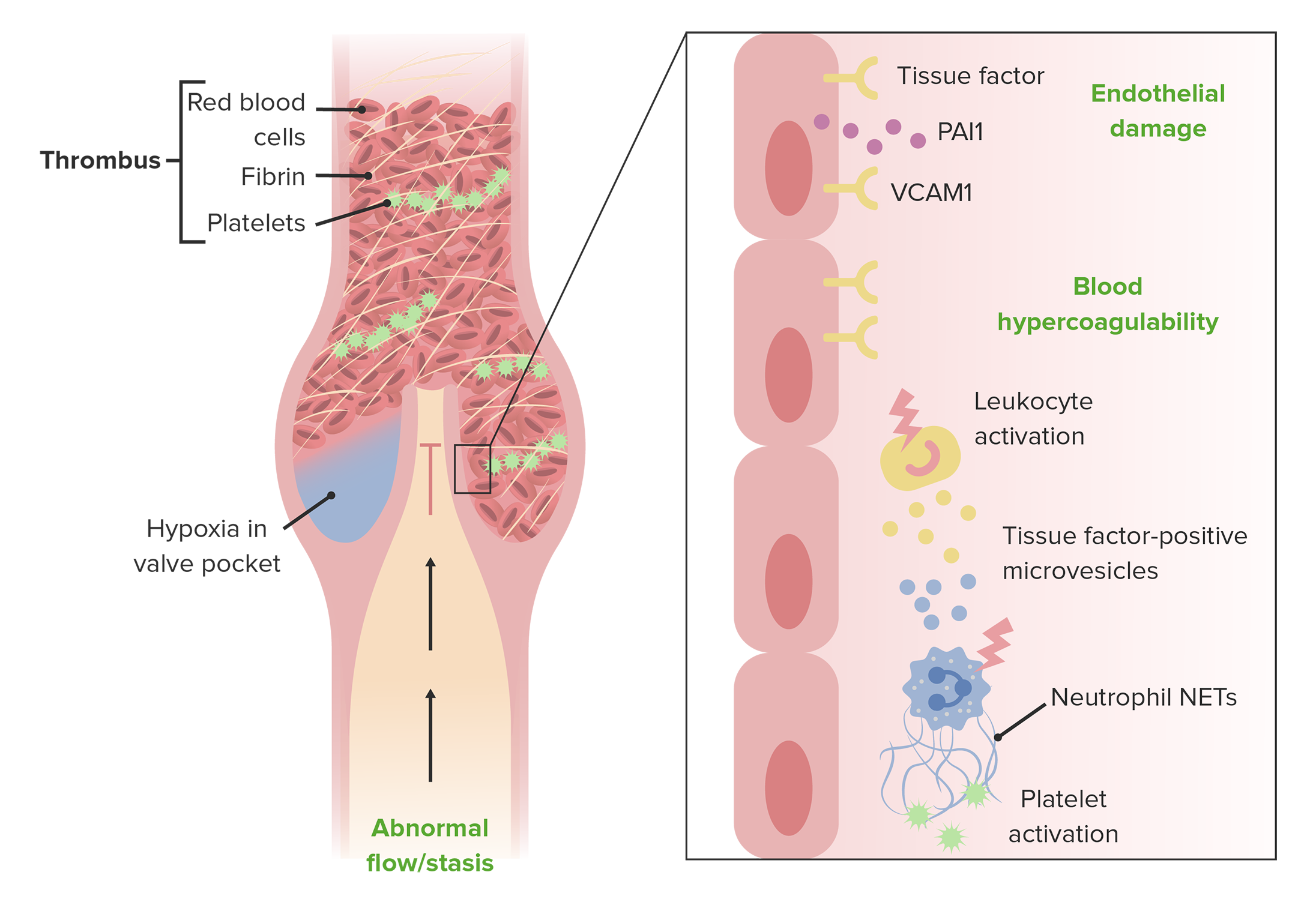Playlist
Show Playlist
Hide Playlist
Deep Vein Thrombosis: Therapy
-
Slides 10 VascularMedicine advanced.pdf
-
Reference List Vascular Medicine.pdf
-
Download Lecture Overview
00:00 Of course, when there's intravascular coagulation or blood clotting, the treatment is going to be intravenous and/or subcutaneous injection of an anticoagulant—for example, heparin or an oral agent (warfarin) or one of the new agents (dabigatran, rivaroxaban, apixaban, or edoxaban). All of these have been approved and are very effective for treating DVT and pulmonary embolism. What they do is they prevent the clot from propagating, and then the body's own enzymes break up the clot slowly over time. One can give heparin that's unfractionated—a big molecule. That's associated with a little more complications than the newer form of heparin, which is only partial… part of the heparin molecule which causes the anticoagulant effect. The major problem, major side effect, is bleeding. When you thin the blood, there's always a risk for bleeding internally or externally. 00:57 One can do surgery or catheter removal of the clots, or one can actually put a filter in the vena cava to prevent the clot from coming up. This is only done in critically ill or high-risk patients. And finally, where there's a huge amount of clot, we can give thrombolytic drugs that are known as clot busters. They dissolve the clot. They're actually chemicals that are based on the body's own thrombolytic enzymes, but in much higher concentration, and therefore are very effective at dissolving the clots. 01:28 Chronic therapy: If the patient has one of these hypercoagulable inherited factors, it may be that they need anticoagulants for the rest of their life. But in general, usually six months to a year of anticoagulant therapy and then stopping and seeing what happens. 01:44 I've already mentioned that there's warfarin. Warfarin is a thinner that requires frequent blood tests to make sure that the level is adequate or not excessive. But the new oral anticoagulants—dabigatran, rivaroxaban, apixaban, and edoxaban—do not require blood tests. They don't require special dietary restrictions, as with warfarin. And they are very, very popular. Again, because they're new, they're more expensive. In the United States, most insurance companies cover these new agents with only a modest additional co-pay, and many patients are choosing this instead of warfarin, the older therapy. 02:25 And, of course, exercise: frequent walking. The muscle pump helps to milk the veins and prevent stasis. Compressive stockings (we've talked about that) again help prevent venous stasis. By the way, we talked about the fact that when you've had one episode, you're markedly likely to have another episode. Here, you see from a study that followed patients who had a first episode of DVT with pulmonary embolism for eight years, and you can see what happened. In the first year, there was already 5% had a recurrence. The second year, 10%. And already, by the eighth year, almost 30% of the patients had had a recurrence. 03:03 So this is a major risk factor for further DVT/PE when you've had one episode. 03:11 In terms of prevention, of course, we want to try and prevent injury to the vein. We want to try and prevent hypercoagulability, and we want to try and prevent stasis. Some patients who are high-risk will have anticoagulants after delivering a baby (postpartum) and early ambulation after surgery. Antiembolism stockings: We've talked about that, the compressive stockings. 03:36 Some patients use pneumatic compressive devices when they're in the hospital to keep squeezing the calves, to keep squeezing the blood out. We can elevate the leg, to cause better venous emptying, every hour or so. Permanent elevation of the leg also helps to prevent stasis. And then after surgery or any injury, the sooner one gets the patient to ambulate and get the muscle pump working on the veins, again, the better.
About the Lecture
The lecture Deep Vein Thrombosis: Therapy by Joseph Alpert, MD is from the course Venous Diseases.
Included Quiz Questions
Which of the following is NOT used to prevent deep venous thrombosis?
- Ginseng pills.
- Compression stockings.
- Anticoagulation therapy.
- Elevation of the legs.
Which of the following is the treatment only for high-risk or critically ill patients?
- Placing filter in vena cava.
- Anticoagulants.
- Heparin.
- Unfractionated heparin.
- Warfarin.
Customer reviews
5,0 of 5 stars
| 5 Stars |
|
5 |
| 4 Stars |
|
0 |
| 3 Stars |
|
0 |
| 2 Stars |
|
0 |
| 1 Star |
|
0 |





